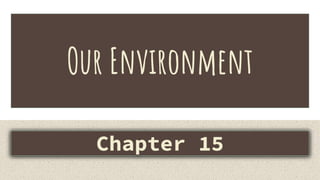This chapter discusses key topics related to ecosystems and the environment, including different types of waste and their effects; components and types of ecosystems; trophic levels and how energy flows between them; food chains and webs; and how human activities can impact the natural environment. Biodegradable waste can decompose and cause smells or disease if used in large quantities, while non-biodegradable waste pollutes land and water. Ecosystems contain biotic factors like producers, consumers, and decomposers, as well as abiotic factors that influence biodiversity. Energy is transferred between trophic levels and concentrated upwards, while human activities like CFC emissions can deplete the ozone layer.


















